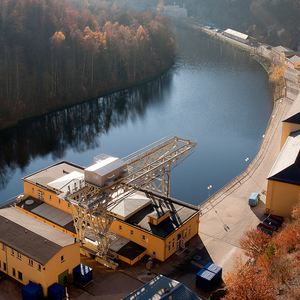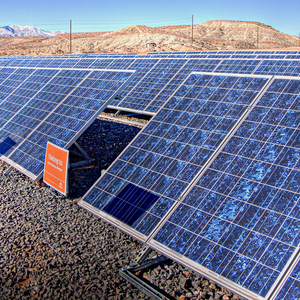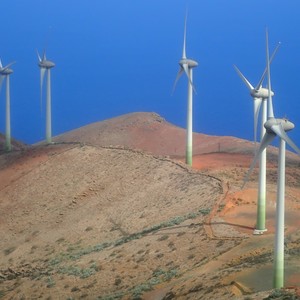
Renewable energy is like local produce: abundant at times, scarce at others. This analogy has been at the front of my mind lately. Our family joined a Community Supported Agriculture (CSA) operation, and every Sunday, I drop by the farm to pick up our share of the harvest. This week’s box—the “small” share—contains lettuce, kale, cabbage, beets, potatoes, carrots, beans, and squash, all wonderfully fresh and clearly grown with love.
Mixed with my delight at this haul of produce is always a note of dread. What am I going to do with all these veggies? There’s no way to eat them before the next box arrives, and I can’t bear to see them go to waste. The answer, of course, is to store them. I’ve started blanching and freezing the greens and wax beans, knowing that next February, I’ll still be enjoying this summer’s bounty.
The CSA provides only a small fraction of our family’s annual food needs. If I wanted to increase that fraction, I’d need to buy a larger share, and I’d also need to raise my storage game. If I wanted to live entirely on local produce, I’d need to re-learn the full suite of techniques—drying, canning, pickling, and root cellar storage—that my great grandparents employed a hundred years ago on their farm in Ohio.
Demand and the duck curve
Like local produce, the availability of wind and solar electricity varies over time. Photovoltaic (PV) modules only generate electricity when the sun is shining; wind turbines only produce when the wind blows. These resources fluctuate over the course of a day, day to day, and season to season. This variability presents a challenge to electric utilities, which are tasked with making sure power…
Weekly Newsletter
Get building science and energy efficiency advice, plus special offers, in your inbox.

This article is only available to GBA Prime Members
Sign up for a free trial and get instant access to this article as well as GBA’s complete library of premium articles and construction details.
Start Free TrialAlready a member? Log in















7 Comments
Other factors that might help:
-- Distributed storage -- In Vermont, some customers participated in a trial in which the electric utility installed Tesla Powerwalls in homes, with the proviso that the utility could charge and discharge that battery to help them smooth out the duck curve. Customers also could use the battery.
-- Incentives for off-peak usage could help the duck curve. Customers will have electric vehicles and home batteries that can be charged overnight when lower electric rates are offered, and use the batteries during peak usage times when rates are higher. Some customers would be happy to help out reduce the duck curve and benefit from it.
-- Distributed demand - In some areas, customers who are willing to allow the electric utility to control their demand, and thereby get lowered electric rates. The utility has some control over the electricity usage in the household. For example, can charge or discharge your electric vehicle battery, your Tesla powerwall home battery, control your hot water heater heating cycle somewhat, or other home appliances to smooth out demand.
-- Demand charges: In addition to charging more for electricity usage during peak times and less during low usage hours, the total peak household demand for electricity at any one time could result in increased charges. In Colorado, we were charged for the highest peak home demand per each month, multiplied by the total electrical usage per month. So household usage peaks had a large effect on your bill. The thinking was it would encourage customers to reduce some home electricity usage during their usual peak dinnertime usage. Avoid running the clothes dryer, dishwasher or oven while cooking dinner, for example.
Robert,
Another dimension to this may be that how comfortable individuals are with grid tied arrangements like distributed storage might turn out to be very defendant on trust, and on whether the utilities are privately or publicly owned. The problems Texas had, and Britain is experiencing now with private utilities make me wonder if we might see different solutions is some places based not on which technology is the most appropriate, but rather whether people feel confident in the decisions the grid owners will make.
Yes a lot of conflicts among utilities, government regulators, and the public in the US. Complicates technical problem-solving when there are many stakeholders involved with different priorities.
Yet another reason to build or renovate "pretty good", Passive House/PHIUS or other more resilient housing, or decentralized electrical power options. 246 deaths attributed to the Texas power outage, two-thirds from hypothermia in a southern state like Texas, no less. Lots of electrical grid shutdowns in CA from wildfire-related events, and wherever major hurricanes strike.
New products like the Tesla powerwall and Ford F-150 Lightning job site power capabilities seem like interesting new products that could be very useful in shorter-term power outages. Seems very unfortunate that most residential PV can't be used in a power outage.
Hi Robert,
These are great points--distributed storage, time-of-use pricing, and other approaches to demand management will be a big part of the solution. I think of these plus renewables and grid-scale storage as "resources" that will sometimes compete but will also to some extent complement each other to provide more flexibility and resilience.
Thanks Jon. Fascinating stuff!
Yes thanks for the clear explanation of emerging electrical grid storage options.
Ammonia could be a storage method for energy in many cases including farms and homes. Ammonia is more useful, much easer and more dense than H alone. I can envision the Ammonia truck come by the farm (wind, solar and food) and collect Green Ammonia and write a big check and the kids can stay on the farm if they want.
Log in or become a member to post a comment.
Sign up Log in